BSBFIM601 Manage Finances: Comprehensive Task 3 Assignment Solution
VerifiedAdded on 2022/08/21
|7
|2979
|14
Homework Assignment
AI Summary
This document contains a comprehensive solution for BSBFIM601 Manage Finances Assessment Task 3. It addresses various aspects of financial management, starting with defining and describing financial probity requirements and identifying fraudulent behaviors. The solution delves into the requirements for audited accounts, the purpose of audit reports, and the principles of both cash and accrual accounting, including their advantages and disadvantages. It further elaborates on taxation and superannuation obligations, detailing ABN requirements, GST, PAYG, and superannuation contributions. The document also outlines the requirements for financial reporting and auditing under the Corporations Act 2001, along with specifics for foreign companies. It covers current company tax rates, the process of reporting GST, penalties for non-compliance (ABN), and GST registration thresholds for non-profit organizations. Additionally, the solution clarifies PAYG withholding obligations for employees and contractors. The assignment also includes a case study analysis of a leadership consultancy, requiring a financial performance report, budget forecasts, and a report on key financial compliance requirements and tax liabilities, offering a practical application of the theoretical concepts discussed.
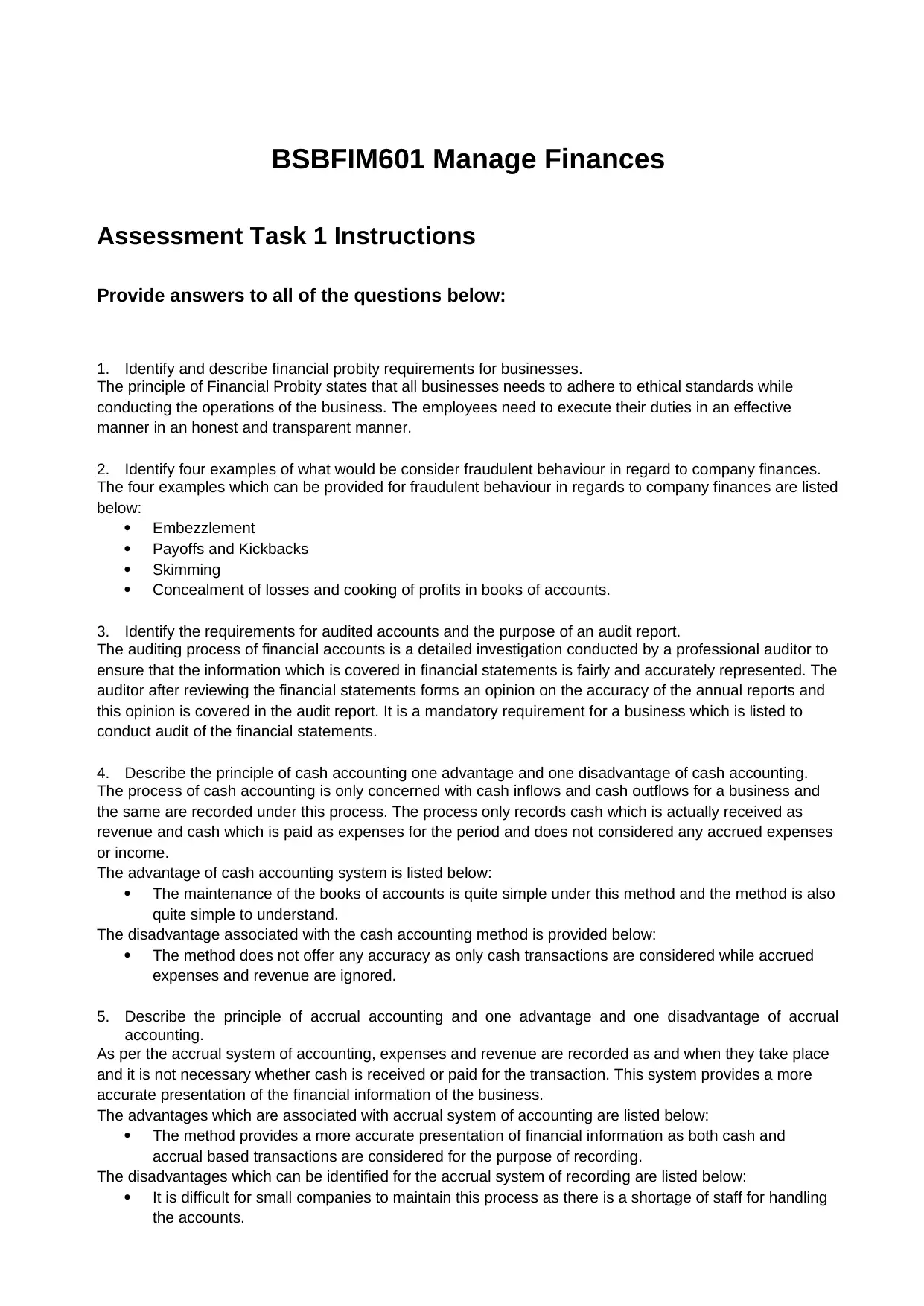
BSBFIM601 Manage Finances
Assessment Task 1 Instructions
Provide answers to all of the questions below:
1. Identify and describe financial probity requirements for businesses.
The principle of Financial Probity states that all businesses needs to adhere to ethical standards while
conducting the operations of the business. The employees need to execute their duties in an effective
manner in an honest and transparent manner.
2. Identify four examples of what would be consider fraudulent behaviour in regard to company finances.
The four examples which can be provided for fraudulent behaviour in regards to company finances are listed
below:
Embezzlement
Payoffs and Kickbacks
Skimming
Concealment of losses and cooking of profits in books of accounts.
3. Identify the requirements for audited accounts and the purpose of an audit report.
The auditing process of financial accounts is a detailed investigation conducted by a professional auditor to
ensure that the information which is covered in financial statements is fairly and accurately represented. The
auditor after reviewing the financial statements forms an opinion on the accuracy of the annual reports and
this opinion is covered in the audit report. It is a mandatory requirement for a business which is listed to
conduct audit of the financial statements.
4. Describe the principle of cash accounting one advantage and one disadvantage of cash accounting.
The process of cash accounting is only concerned with cash inflows and cash outflows for a business and
the same are recorded under this process. The process only records cash which is actually received as
revenue and cash which is paid as expenses for the period and does not considered any accrued expenses
or income.
The advantage of cash accounting system is listed below:
The maintenance of the books of accounts is quite simple under this method and the method is also
quite simple to understand.
The disadvantage associated with the cash accounting method is provided below:
The method does not offer any accuracy as only cash transactions are considered while accrued
expenses and revenue are ignored.
5. Describe the principle of accrual accounting and one advantage and one disadvantage of accrual
accounting.
As per the accrual system of accounting, expenses and revenue are recorded as and when they take place
and it is not necessary whether cash is received or paid for the transaction. This system provides a more
accurate presentation of the financial information of the business.
The advantages which are associated with accrual system of accounting are listed below:
The method provides a more accurate presentation of financial information as both cash and
accrual based transactions are considered for the purpose of recording.
The disadvantages which can be identified for the accrual system of recording are listed below:
It is difficult for small companies to maintain this process as there is a shortage of staff for handling
the accounts.
Assessment Task 1 Instructions
Provide answers to all of the questions below:
1. Identify and describe financial probity requirements for businesses.
The principle of Financial Probity states that all businesses needs to adhere to ethical standards while
conducting the operations of the business. The employees need to execute their duties in an effective
manner in an honest and transparent manner.
2. Identify four examples of what would be consider fraudulent behaviour in regard to company finances.
The four examples which can be provided for fraudulent behaviour in regards to company finances are listed
below:
Embezzlement
Payoffs and Kickbacks
Skimming
Concealment of losses and cooking of profits in books of accounts.
3. Identify the requirements for audited accounts and the purpose of an audit report.
The auditing process of financial accounts is a detailed investigation conducted by a professional auditor to
ensure that the information which is covered in financial statements is fairly and accurately represented. The
auditor after reviewing the financial statements forms an opinion on the accuracy of the annual reports and
this opinion is covered in the audit report. It is a mandatory requirement for a business which is listed to
conduct audit of the financial statements.
4. Describe the principle of cash accounting one advantage and one disadvantage of cash accounting.
The process of cash accounting is only concerned with cash inflows and cash outflows for a business and
the same are recorded under this process. The process only records cash which is actually received as
revenue and cash which is paid as expenses for the period and does not considered any accrued expenses
or income.
The advantage of cash accounting system is listed below:
The maintenance of the books of accounts is quite simple under this method and the method is also
quite simple to understand.
The disadvantage associated with the cash accounting method is provided below:
The method does not offer any accuracy as only cash transactions are considered while accrued
expenses and revenue are ignored.
5. Describe the principle of accrual accounting and one advantage and one disadvantage of accrual
accounting.
As per the accrual system of accounting, expenses and revenue are recorded as and when they take place
and it is not necessary whether cash is received or paid for the transaction. This system provides a more
accurate presentation of the financial information of the business.
The advantages which are associated with accrual system of accounting are listed below:
The method provides a more accurate presentation of financial information as both cash and
accrual based transactions are considered for the purpose of recording.
The disadvantages which can be identified for the accrual system of recording are listed below:
It is difficult for small companies to maintain this process as there is a shortage of staff for handling
the accounts.
Paraphrase This Document
Need a fresh take? Get an instant paraphrase of this document with our AI Paraphraser
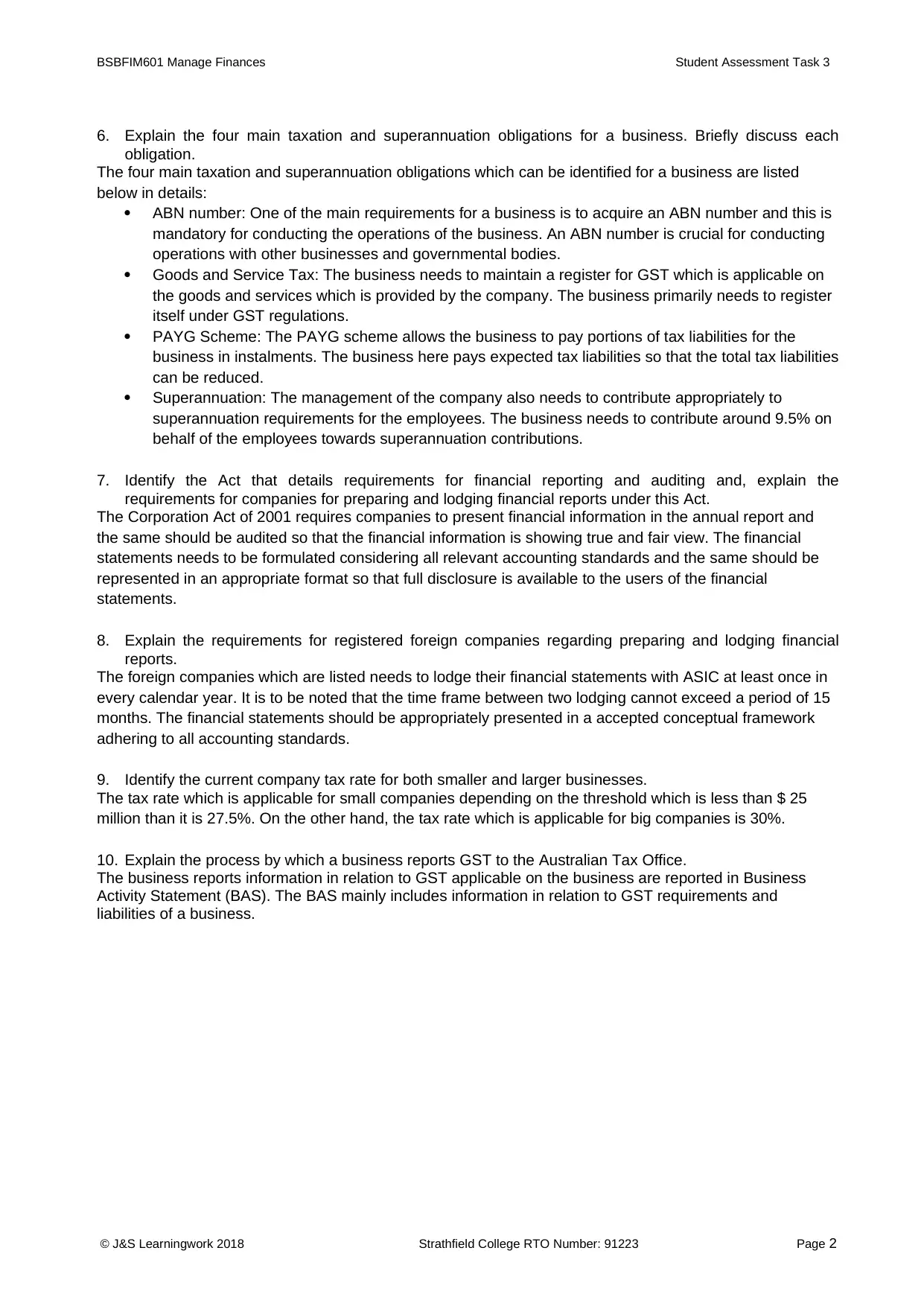
BSBFIM601 Manage Finances Student Assessment Task 3
6. Explain the four main taxation and superannuation obligations for a business. Briefly discuss each
obligation.
The four main taxation and superannuation obligations which can be identified for a business are listed
below in details:
ABN number: One of the main requirements for a business is to acquire an ABN number and this is
mandatory for conducting the operations of the business. An ABN number is crucial for conducting
operations with other businesses and governmental bodies.
Goods and Service Tax: The business needs to maintain a register for GST which is applicable on
the goods and services which is provided by the company. The business primarily needs to register
itself under GST regulations.
PAYG Scheme: The PAYG scheme allows the business to pay portions of tax liabilities for the
business in instalments. The business here pays expected tax liabilities so that the total tax liabilities
can be reduced.
Superannuation: The management of the company also needs to contribute appropriately to
superannuation requirements for the employees. The business needs to contribute around 9.5% on
behalf of the employees towards superannuation contributions.
7. Identify the Act that details requirements for financial reporting and auditing and, explain the
requirements for companies for preparing and lodging financial reports under this Act.
The Corporation Act of 2001 requires companies to present financial information in the annual report and
the same should be audited so that the financial information is showing true and fair view. The financial
statements needs to be formulated considering all relevant accounting standards and the same should be
represented in an appropriate format so that full disclosure is available to the users of the financial
statements.
8. Explain the requirements for registered foreign companies regarding preparing and lodging financial
reports.
The foreign companies which are listed needs to lodge their financial statements with ASIC at least once in
every calendar year. It is to be noted that the time frame between two lodging cannot exceed a period of 15
months. The financial statements should be appropriately presented in a accepted conceptual framework
adhering to all accounting standards.
9. Identify the current company tax rate for both smaller and larger businesses.
The tax rate which is applicable for small companies depending on the threshold which is less than $ 25
million than it is 27.5%. On the other hand, the tax rate which is applicable for big companies is 30%.
10. Explain the process by which a business reports GST to the Australian Tax Office.
The business reports information in relation to GST applicable on the business are reported in Business
Activity Statement (BAS). The BAS mainly includes information in relation to GST requirements and
liabilities of a business.
© J&S Learningwork 2018 Strathfield College RTO Number: 91223 Page 2
6. Explain the four main taxation and superannuation obligations for a business. Briefly discuss each
obligation.
The four main taxation and superannuation obligations which can be identified for a business are listed
below in details:
ABN number: One of the main requirements for a business is to acquire an ABN number and this is
mandatory for conducting the operations of the business. An ABN number is crucial for conducting
operations with other businesses and governmental bodies.
Goods and Service Tax: The business needs to maintain a register for GST which is applicable on
the goods and services which is provided by the company. The business primarily needs to register
itself under GST regulations.
PAYG Scheme: The PAYG scheme allows the business to pay portions of tax liabilities for the
business in instalments. The business here pays expected tax liabilities so that the total tax liabilities
can be reduced.
Superannuation: The management of the company also needs to contribute appropriately to
superannuation requirements for the employees. The business needs to contribute around 9.5% on
behalf of the employees towards superannuation contributions.
7. Identify the Act that details requirements for financial reporting and auditing and, explain the
requirements for companies for preparing and lodging financial reports under this Act.
The Corporation Act of 2001 requires companies to present financial information in the annual report and
the same should be audited so that the financial information is showing true and fair view. The financial
statements needs to be formulated considering all relevant accounting standards and the same should be
represented in an appropriate format so that full disclosure is available to the users of the financial
statements.
8. Explain the requirements for registered foreign companies regarding preparing and lodging financial
reports.
The foreign companies which are listed needs to lodge their financial statements with ASIC at least once in
every calendar year. It is to be noted that the time frame between two lodging cannot exceed a period of 15
months. The financial statements should be appropriately presented in a accepted conceptual framework
adhering to all accounting standards.
9. Identify the current company tax rate for both smaller and larger businesses.
The tax rate which is applicable for small companies depending on the threshold which is less than $ 25
million than it is 27.5%. On the other hand, the tax rate which is applicable for big companies is 30%.
10. Explain the process by which a business reports GST to the Australian Tax Office.
The business reports information in relation to GST applicable on the business are reported in Business
Activity Statement (BAS). The BAS mainly includes information in relation to GST requirements and
liabilities of a business.
© J&S Learningwork 2018 Strathfield College RTO Number: 91223 Page 2
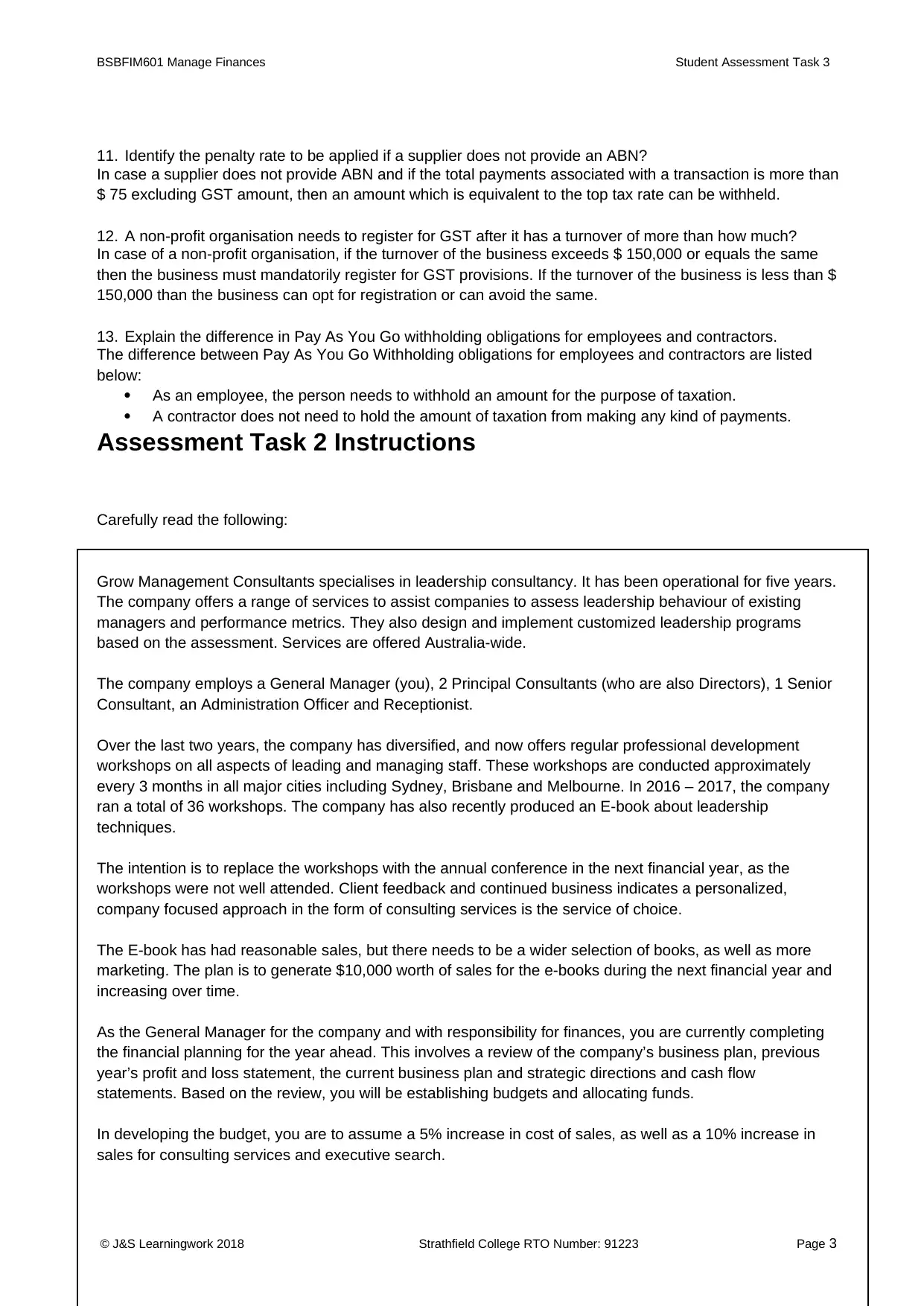
BSBFIM601 Manage Finances Student Assessment Task 3
11. Identify the penalty rate to be applied if a supplier does not provide an ABN?
In case a supplier does not provide ABN and if the total payments associated with a transaction is more than
$ 75 excluding GST amount, then an amount which is equivalent to the top tax rate can be withheld.
12. A non-profit organisation needs to register for GST after it has a turnover of more than how much?
In case of a non-profit organisation, if the turnover of the business exceeds $ 150,000 or equals the same
then the business must mandatorily register for GST provisions. If the turnover of the business is less than $
150,000 than the business can opt for registration or can avoid the same.
13. Explain the difference in Pay As You Go withholding obligations for employees and contractors.
The difference between Pay As You Go Withholding obligations for employees and contractors are listed
below:
As an employee, the person needs to withhold an amount for the purpose of taxation.
A contractor does not need to hold the amount of taxation from making any kind of payments.
Assessment Task 2 Instructions
Carefully read the following:
Grow Management Consultants specialises in leadership consultancy. It has been operational for five years.
The company offers a range of services to assist companies to assess leadership behaviour of existing
managers and performance metrics. They also design and implement customized leadership programs
based on the assessment. Services are offered Australia-wide.
The company employs a General Manager (you), 2 Principal Consultants (who are also Directors), 1 Senior
Consultant, an Administration Officer and Receptionist.
Over the last two years, the company has diversified, and now offers regular professional development
workshops on all aspects of leading and managing staff. These workshops are conducted approximately
every 3 months in all major cities including Sydney, Brisbane and Melbourne. In 2016 – 2017, the company
ran a total of 36 workshops. The company has also recently produced an E-book about leadership
techniques.
The intention is to replace the workshops with the annual conference in the next financial year, as the
workshops were not well attended. Client feedback and continued business indicates a personalized,
company focused approach in the form of consulting services is the service of choice.
The E-book has had reasonable sales, but there needs to be a wider selection of books, as well as more
marketing. The plan is to generate $10,000 worth of sales for the e-books during the next financial year and
increasing over time.
As the General Manager for the company and with responsibility for finances, you are currently completing
the financial planning for the year ahead. This involves a review of the company’s business plan, previous
year’s profit and loss statement, the current business plan and strategic directions and cash flow
statements. Based on the review, you will be establishing budgets and allocating funds.
In developing the budget, you are to assume a 5% increase in cost of sales, as well as a 10% increase in
sales for consulting services and executive search.
© J&S Learningwork 2018 Strathfield College RTO Number: 91223 Page 3
11. Identify the penalty rate to be applied if a supplier does not provide an ABN?
In case a supplier does not provide ABN and if the total payments associated with a transaction is more than
$ 75 excluding GST amount, then an amount which is equivalent to the top tax rate can be withheld.
12. A non-profit organisation needs to register for GST after it has a turnover of more than how much?
In case of a non-profit organisation, if the turnover of the business exceeds $ 150,000 or equals the same
then the business must mandatorily register for GST provisions. If the turnover of the business is less than $
150,000 than the business can opt for registration or can avoid the same.
13. Explain the difference in Pay As You Go withholding obligations for employees and contractors.
The difference between Pay As You Go Withholding obligations for employees and contractors are listed
below:
As an employee, the person needs to withhold an amount for the purpose of taxation.
A contractor does not need to hold the amount of taxation from making any kind of payments.
Assessment Task 2 Instructions
Carefully read the following:
Grow Management Consultants specialises in leadership consultancy. It has been operational for five years.
The company offers a range of services to assist companies to assess leadership behaviour of existing
managers and performance metrics. They also design and implement customized leadership programs
based on the assessment. Services are offered Australia-wide.
The company employs a General Manager (you), 2 Principal Consultants (who are also Directors), 1 Senior
Consultant, an Administration Officer and Receptionist.
Over the last two years, the company has diversified, and now offers regular professional development
workshops on all aspects of leading and managing staff. These workshops are conducted approximately
every 3 months in all major cities including Sydney, Brisbane and Melbourne. In 2016 – 2017, the company
ran a total of 36 workshops. The company has also recently produced an E-book about leadership
techniques.
The intention is to replace the workshops with the annual conference in the next financial year, as the
workshops were not well attended. Client feedback and continued business indicates a personalized,
company focused approach in the form of consulting services is the service of choice.
The E-book has had reasonable sales, but there needs to be a wider selection of books, as well as more
marketing. The plan is to generate $10,000 worth of sales for the e-books during the next financial year and
increasing over time.
As the General Manager for the company and with responsibility for finances, you are currently completing
the financial planning for the year ahead. This involves a review of the company’s business plan, previous
year’s profit and loss statement, the current business plan and strategic directions and cash flow
statements. Based on the review, you will be establishing budgets and allocating funds.
In developing the budget, you are to assume a 5% increase in cost of sales, as well as a 10% increase in
sales for consulting services and executive search.
© J&S Learningwork 2018 Strathfield College RTO Number: 91223 Page 3
⊘ This is a preview!⊘
Do you want full access?
Subscribe today to unlock all pages.

Trusted by 1+ million students worldwide
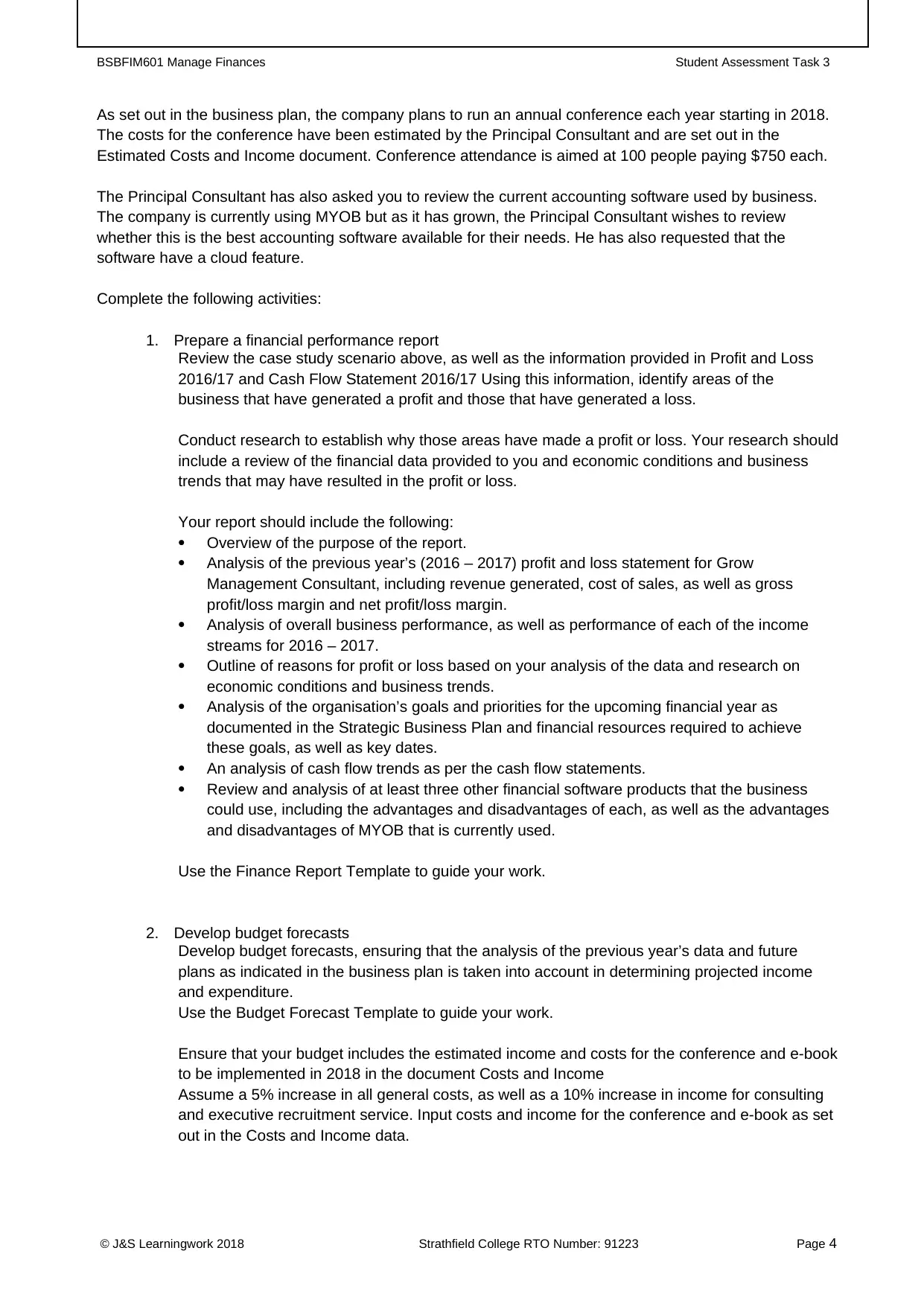
BSBFIM601 Manage Finances Student Assessment Task 3
As set out in the business plan, the company plans to run an annual conference each year starting in 2018.
The costs for the conference have been estimated by the Principal Consultant and are set out in the
Estimated Costs and Income document. Conference attendance is aimed at 100 people paying $750 each.
The Principal Consultant has also asked you to review the current accounting software used by business.
The company is currently using MYOB but as it has grown, the Principal Consultant wishes to review
whether this is the best accounting software available for their needs. He has also requested that the
software have a cloud feature.
Complete the following activities:
1. Prepare a financial performance report
Review the case study scenario above, as well as the information provided in Profit and Loss
2016/17 and Cash Flow Statement 2016/17 Using this information, identify areas of the
business that have generated a profit and those that have generated a loss.
Conduct research to establish why those areas have made a profit or loss. Your research should
include a review of the financial data provided to you and economic conditions and business
trends that may have resulted in the profit or loss.
Your report should include the following:
Overview of the purpose of the report.
Analysis of the previous year’s (2016 – 2017) profit and loss statement for Grow
Management Consultant, including revenue generated, cost of sales, as well as gross
profit/loss margin and net profit/loss margin.
Analysis of overall business performance, as well as performance of each of the income
streams for 2016 – 2017.
Outline of reasons for profit or loss based on your analysis of the data and research on
economic conditions and business trends.
Analysis of the organisation’s goals and priorities for the upcoming financial year as
documented in the Strategic Business Plan and financial resources required to achieve
these goals, as well as key dates.
An analysis of cash flow trends as per the cash flow statements.
Review and analysis of at least three other financial software products that the business
could use, including the advantages and disadvantages of each, as well as the advantages
and disadvantages of MYOB that is currently used.
Use the Finance Report Template to guide your work.
2. Develop budget forecasts
Develop budget forecasts, ensuring that the analysis of the previous year’s data and future
plans as indicated in the business plan is taken into account in determining projected income
and expenditure.
Use the Budget Forecast Template to guide your work.
Ensure that your budget includes the estimated income and costs for the conference and e-book
to be implemented in 2018 in the document Costs and Income
Assume a 5% increase in all general costs, as well as a 10% increase in income for consulting
and executive recruitment service. Input costs and income for the conference and e-book as set
out in the Costs and Income data.
© J&S Learningwork 2018 Strathfield College RTO Number: 91223 Page 4
As set out in the business plan, the company plans to run an annual conference each year starting in 2018.
The costs for the conference have been estimated by the Principal Consultant and are set out in the
Estimated Costs and Income document. Conference attendance is aimed at 100 people paying $750 each.
The Principal Consultant has also asked you to review the current accounting software used by business.
The company is currently using MYOB but as it has grown, the Principal Consultant wishes to review
whether this is the best accounting software available for their needs. He has also requested that the
software have a cloud feature.
Complete the following activities:
1. Prepare a financial performance report
Review the case study scenario above, as well as the information provided in Profit and Loss
2016/17 and Cash Flow Statement 2016/17 Using this information, identify areas of the
business that have generated a profit and those that have generated a loss.
Conduct research to establish why those areas have made a profit or loss. Your research should
include a review of the financial data provided to you and economic conditions and business
trends that may have resulted in the profit or loss.
Your report should include the following:
Overview of the purpose of the report.
Analysis of the previous year’s (2016 – 2017) profit and loss statement for Grow
Management Consultant, including revenue generated, cost of sales, as well as gross
profit/loss margin and net profit/loss margin.
Analysis of overall business performance, as well as performance of each of the income
streams for 2016 – 2017.
Outline of reasons for profit or loss based on your analysis of the data and research on
economic conditions and business trends.
Analysis of the organisation’s goals and priorities for the upcoming financial year as
documented in the Strategic Business Plan and financial resources required to achieve
these goals, as well as key dates.
An analysis of cash flow trends as per the cash flow statements.
Review and analysis of at least three other financial software products that the business
could use, including the advantages and disadvantages of each, as well as the advantages
and disadvantages of MYOB that is currently used.
Use the Finance Report Template to guide your work.
2. Develop budget forecasts
Develop budget forecasts, ensuring that the analysis of the previous year’s data and future
plans as indicated in the business plan is taken into account in determining projected income
and expenditure.
Use the Budget Forecast Template to guide your work.
Ensure that your budget includes the estimated income and costs for the conference and e-book
to be implemented in 2018 in the document Costs and Income
Assume a 5% increase in all general costs, as well as a 10% increase in income for consulting
and executive recruitment service. Input costs and income for the conference and e-book as set
out in the Costs and Income data.
© J&S Learningwork 2018 Strathfield College RTO Number: 91223 Page 4
Paraphrase This Document
Need a fresh take? Get an instant paraphrase of this document with our AI Paraphraser
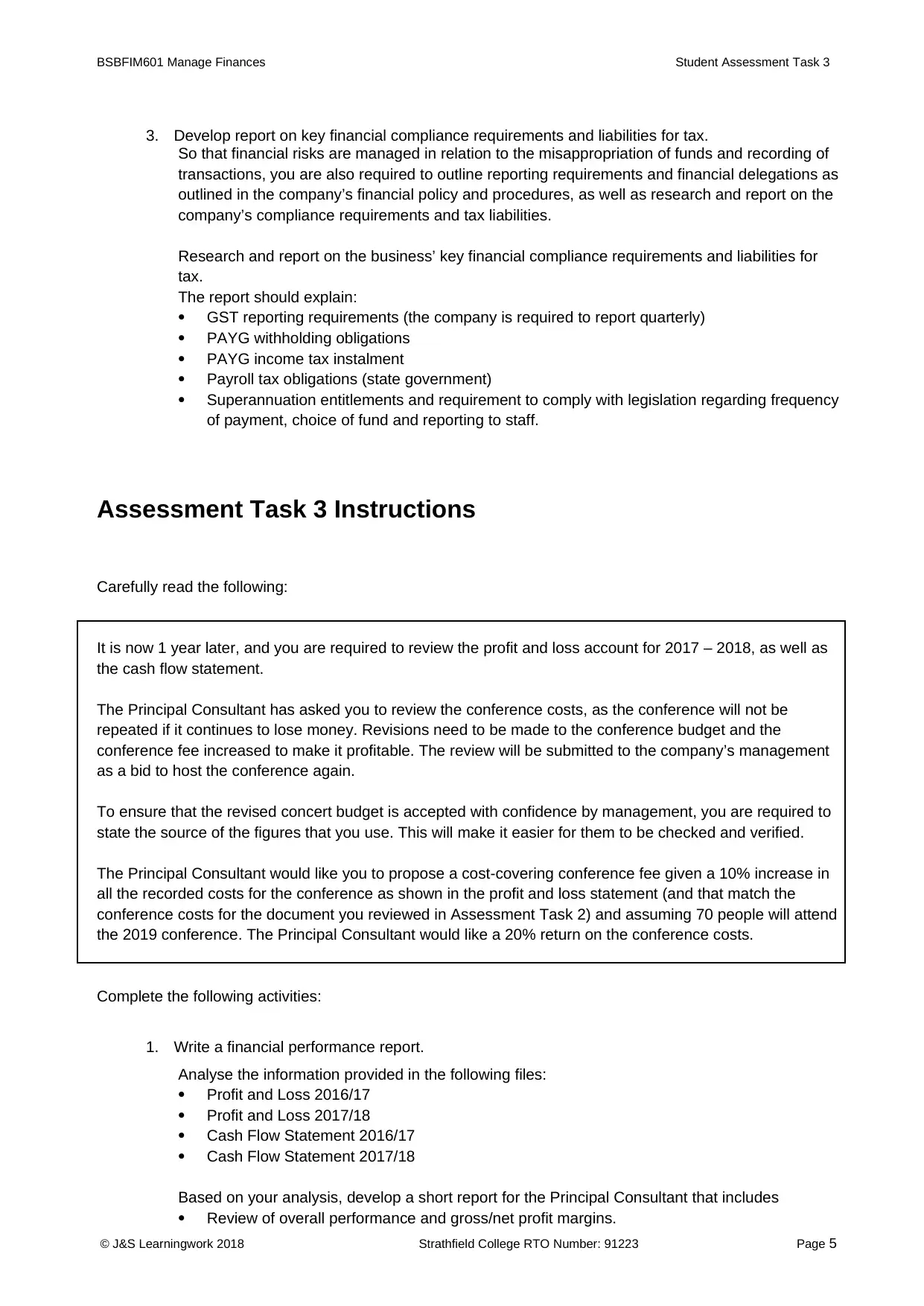
BSBFIM601 Manage Finances Student Assessment Task 3
3. Develop report on key financial compliance requirements and liabilities for tax.
So that financial risks are managed in relation to the misappropriation of funds and recording of
transactions, you are also required to outline reporting requirements and financial delegations as
outlined in the company’s financial policy and procedures, as well as research and report on the
company’s compliance requirements and tax liabilities.
Research and report on the business’ key financial compliance requirements and liabilities for
tax.
The report should explain:
GST reporting requirements (the company is required to report quarterly)
PAYG withholding obligations
PAYG income tax instalment
Payroll tax obligations (state government)
Superannuation entitlements and requirement to comply with legislation regarding frequency
of payment, choice of fund and reporting to staff.
Assessment Task 3 Instructions
Carefully read the following:
It is now 1 year later, and you are required to review the profit and loss account for 2017 – 2018, as well as
the cash flow statement.
The Principal Consultant has asked you to review the conference costs, as the conference will not be
repeated if it continues to lose money. Revisions need to be made to the conference budget and the
conference fee increased to make it profitable. The review will be submitted to the company’s management
as a bid to host the conference again.
To ensure that the revised concert budget is accepted with confidence by management, you are required to
state the source of the figures that you use. This will make it easier for them to be checked and verified.
The Principal Consultant would like you to propose a cost-covering conference fee given a 10% increase in
all the recorded costs for the conference as shown in the profit and loss statement (and that match the
conference costs for the document you reviewed in Assessment Task 2) and assuming 70 people will attend
the 2019 conference. The Principal Consultant would like a 20% return on the conference costs.
Complete the following activities:
1. Write a financial performance report.
Analyse the information provided in the following files:
Profit and Loss 2016/17
Profit and Loss 2017/18
Cash Flow Statement 2016/17
Cash Flow Statement 2017/18
Based on your analysis, develop a short report for the Principal Consultant that includes
Review of overall performance and gross/net profit margins.
© J&S Learningwork 2018 Strathfield College RTO Number: 91223 Page 5
3. Develop report on key financial compliance requirements and liabilities for tax.
So that financial risks are managed in relation to the misappropriation of funds and recording of
transactions, you are also required to outline reporting requirements and financial delegations as
outlined in the company’s financial policy and procedures, as well as research and report on the
company’s compliance requirements and tax liabilities.
Research and report on the business’ key financial compliance requirements and liabilities for
tax.
The report should explain:
GST reporting requirements (the company is required to report quarterly)
PAYG withholding obligations
PAYG income tax instalment
Payroll tax obligations (state government)
Superannuation entitlements and requirement to comply with legislation regarding frequency
of payment, choice of fund and reporting to staff.
Assessment Task 3 Instructions
Carefully read the following:
It is now 1 year later, and you are required to review the profit and loss account for 2017 – 2018, as well as
the cash flow statement.
The Principal Consultant has asked you to review the conference costs, as the conference will not be
repeated if it continues to lose money. Revisions need to be made to the conference budget and the
conference fee increased to make it profitable. The review will be submitted to the company’s management
as a bid to host the conference again.
To ensure that the revised concert budget is accepted with confidence by management, you are required to
state the source of the figures that you use. This will make it easier for them to be checked and verified.
The Principal Consultant would like you to propose a cost-covering conference fee given a 10% increase in
all the recorded costs for the conference as shown in the profit and loss statement (and that match the
conference costs for the document you reviewed in Assessment Task 2) and assuming 70 people will attend
the 2019 conference. The Principal Consultant would like a 20% return on the conference costs.
Complete the following activities:
1. Write a financial performance report.
Analyse the information provided in the following files:
Profit and Loss 2016/17
Profit and Loss 2017/18
Cash Flow Statement 2016/17
Cash Flow Statement 2017/18
Based on your analysis, develop a short report for the Principal Consultant that includes
Review of overall performance and gross/net profit margins.
© J&S Learningwork 2018 Strathfield College RTO Number: 91223 Page 5
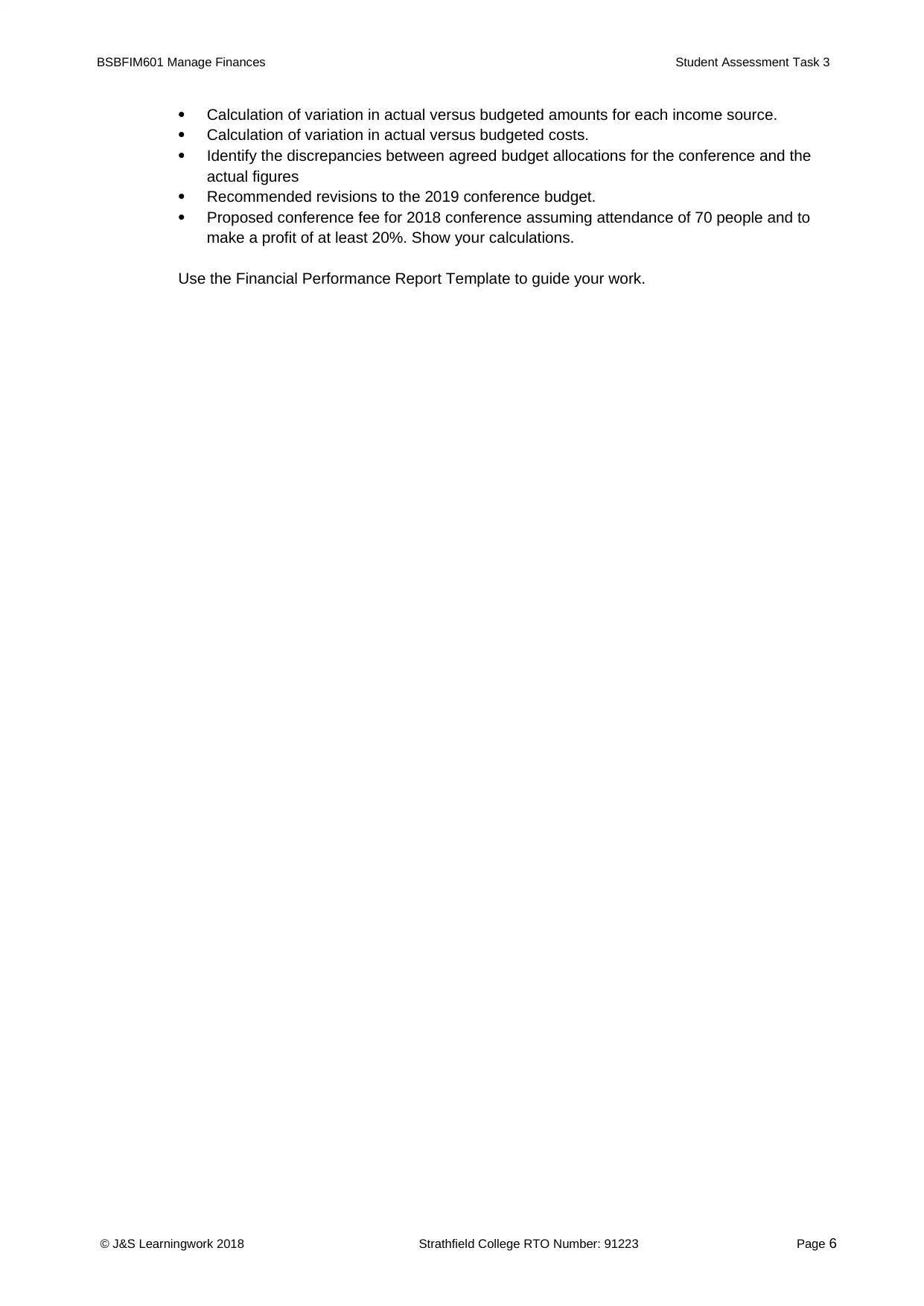
BSBFIM601 Manage Finances Student Assessment Task 3
Calculation of variation in actual versus budgeted amounts for each income source.
Calculation of variation in actual versus budgeted costs.
Identify the discrepancies between agreed budget allocations for the conference and the
actual figures
Recommended revisions to the 2019 conference budget.
Proposed conference fee for 2018 conference assuming attendance of 70 people and to
make a profit of at least 20%. Show your calculations.
Use the Financial Performance Report Template to guide your work.
© J&S Learningwork 2018 Strathfield College RTO Number: 91223 Page 6
Calculation of variation in actual versus budgeted amounts for each income source.
Calculation of variation in actual versus budgeted costs.
Identify the discrepancies between agreed budget allocations for the conference and the
actual figures
Recommended revisions to the 2019 conference budget.
Proposed conference fee for 2018 conference assuming attendance of 70 people and to
make a profit of at least 20%. Show your calculations.
Use the Financial Performance Report Template to guide your work.
© J&S Learningwork 2018 Strathfield College RTO Number: 91223 Page 6
⊘ This is a preview!⊘
Do you want full access?
Subscribe today to unlock all pages.

Trusted by 1+ million students worldwide
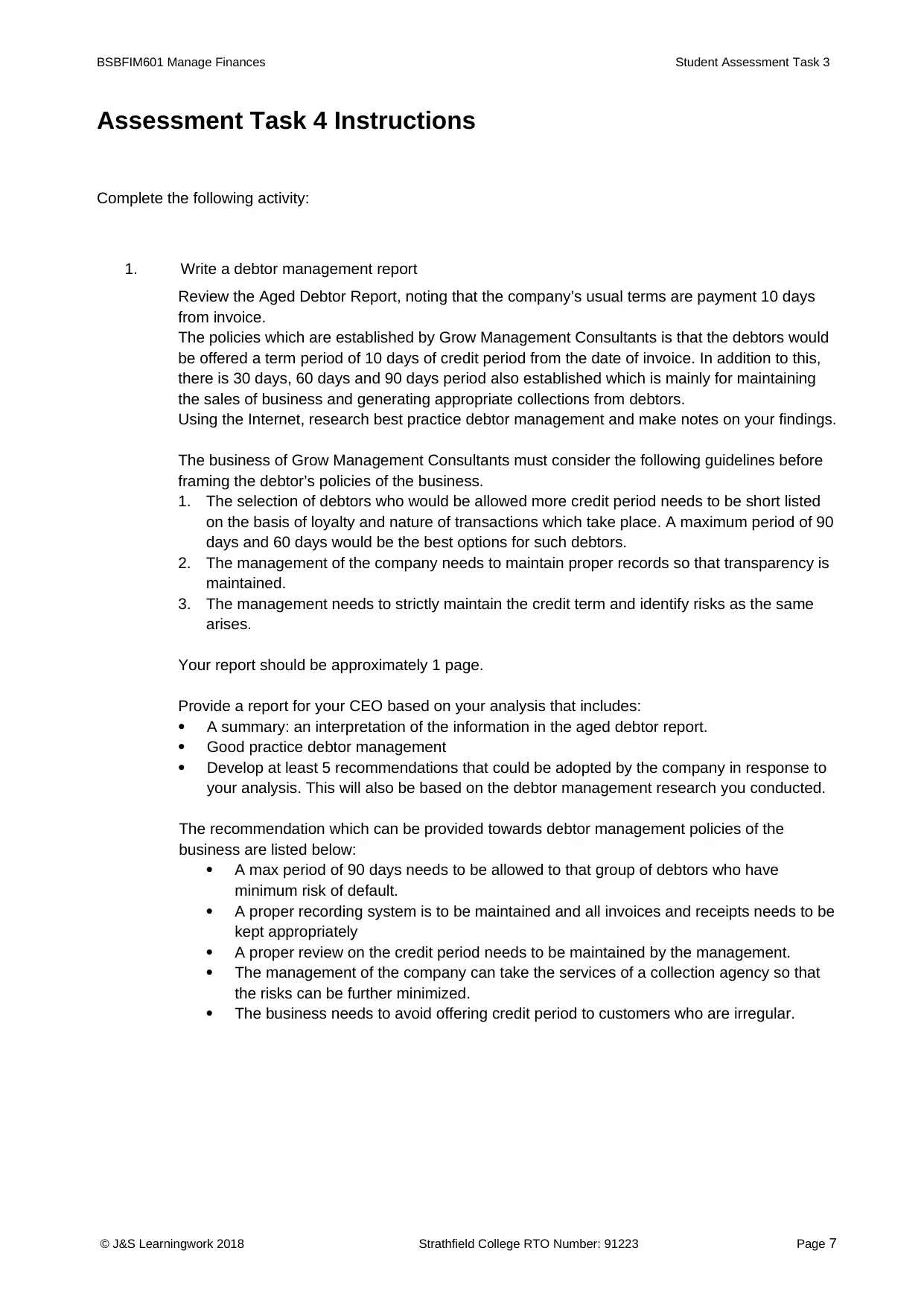
BSBFIM601 Manage Finances Student Assessment Task 3
Assessment Task 4 Instructions
Complete the following activity:
1. Write a debtor management report
Review the Aged Debtor Report, noting that the company’s usual terms are payment 10 days
from invoice.
The policies which are established by Grow Management Consultants is that the debtors would
be offered a term period of 10 days of credit period from the date of invoice. In addition to this,
there is 30 days, 60 days and 90 days period also established which is mainly for maintaining
the sales of business and generating appropriate collections from debtors.
Using the Internet, research best practice debtor management and make notes on your findings.
The business of Grow Management Consultants must consider the following guidelines before
framing the debtor’s policies of the business.
1. The selection of debtors who would be allowed more credit period needs to be short listed
on the basis of loyalty and nature of transactions which take place. A maximum period of 90
days and 60 days would be the best options for such debtors.
2. The management of the company needs to maintain proper records so that transparency is
maintained.
3. The management needs to strictly maintain the credit term and identify risks as the same
arises.
Your report should be approximately 1 page.
Provide a report for your CEO based on your analysis that includes:
A summary: an interpretation of the information in the aged debtor report.
Good practice debtor management
Develop at least 5 recommendations that could be adopted by the company in response to
your analysis. This will also be based on the debtor management research you conducted.
The recommendation which can be provided towards debtor management policies of the
business are listed below:
A max period of 90 days needs to be allowed to that group of debtors who have
minimum risk of default.
A proper recording system is to be maintained and all invoices and receipts needs to be
kept appropriately
A proper review on the credit period needs to be maintained by the management.
The management of the company can take the services of a collection agency so that
the risks can be further minimized.
The business needs to avoid offering credit period to customers who are irregular.
© J&S Learningwork 2018 Strathfield College RTO Number: 91223 Page 7
Assessment Task 4 Instructions
Complete the following activity:
1. Write a debtor management report
Review the Aged Debtor Report, noting that the company’s usual terms are payment 10 days
from invoice.
The policies which are established by Grow Management Consultants is that the debtors would
be offered a term period of 10 days of credit period from the date of invoice. In addition to this,
there is 30 days, 60 days and 90 days period also established which is mainly for maintaining
the sales of business and generating appropriate collections from debtors.
Using the Internet, research best practice debtor management and make notes on your findings.
The business of Grow Management Consultants must consider the following guidelines before
framing the debtor’s policies of the business.
1. The selection of debtors who would be allowed more credit period needs to be short listed
on the basis of loyalty and nature of transactions which take place. A maximum period of 90
days and 60 days would be the best options for such debtors.
2. The management of the company needs to maintain proper records so that transparency is
maintained.
3. The management needs to strictly maintain the credit term and identify risks as the same
arises.
Your report should be approximately 1 page.
Provide a report for your CEO based on your analysis that includes:
A summary: an interpretation of the information in the aged debtor report.
Good practice debtor management
Develop at least 5 recommendations that could be adopted by the company in response to
your analysis. This will also be based on the debtor management research you conducted.
The recommendation which can be provided towards debtor management policies of the
business are listed below:
A max period of 90 days needs to be allowed to that group of debtors who have
minimum risk of default.
A proper recording system is to be maintained and all invoices and receipts needs to be
kept appropriately
A proper review on the credit period needs to be maintained by the management.
The management of the company can take the services of a collection agency so that
the risks can be further minimized.
The business needs to avoid offering credit period to customers who are irregular.
© J&S Learningwork 2018 Strathfield College RTO Number: 91223 Page 7
1 out of 7
Related Documents
Your All-in-One AI-Powered Toolkit for Academic Success.
+13062052269
info@desklib.com
Available 24*7 on WhatsApp / Email
![[object Object]](/_next/static/media/star-bottom.7253800d.svg)
Unlock your academic potential
Copyright © 2020–2025 A2Z Services. All Rights Reserved. Developed and managed by ZUCOL.




